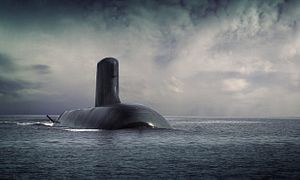The debate over the Royal Australian Navy’s (RAN) future submarine fleet is raging on with a new report urging the Australian government to reconsider its decision to procure redesigned diesel-electrics submarines and opt for modified off-the shelf boats instead, or risk a major capability gap in the near future.
Australia’s submarine project, which aims to replace the RANs fleet of six aging Collins-class submarines designed by Swedish manufacturer Kockums in the 1990s, is “extravagantly expensive, highly risky and in an era of heightened tensions in the Asia Pacific compromises the future defense of Australia,” a recently released Insight Economics report, commissioned by Gary Johnston, a Sydney businessman, states.
Australia and France concluded an intergovernmental agreement (IGA) for the construction of 12 Shortfin Barracuda Block 1A submarines, a diesel-electric derivative of French shipbuilder Direction des Constructions Navales Services’ (DCNS) Barracuda-class nuclear attack submarine under the Royal Australian Navy’s SEA 1000 Future Submarine Program (FSM) in December 2016. The 12 submarines — except for some specialized parts — are slated to be built in Adelaide, home to the Australian Submarine Corporation (ASC).
The report claims that Australia’s new submarine fleet will cost far more than necessary. “We will pay far too much for a boat that will do far too little,” Hugh White, author of the study, said on September 27, during a presentation of the report in Canberra. “Our calculation in the report is that, in 2016 dollars, these 12 boats will cost us $40bn, plus $6bn for the combat system – well over $3bn a boat. In every major project like this, the costs escalate.”
However, according to the report, the bigger risk with sticking to the modified Barracuda-class is that “Australia will be left with a submarine capability that is either seriously inadequate or, in the worst case, non-existent for several years.” The report states:
Engineering experts consider the technical risks around the Shortfin Barracuda to be high. It will be a very large conventional submarine and the engineering challenges are formidable. Most surprisingly, the present concept design does not incorporate modern batteries or AIP, considered by most experts as essential in a future operational environment where submarine detection technologies will have improved significantly.
According to Australia’s 2016 Defense White Paper, the first Shortfin Barracuda will enter enter service in the 2030s, with construction of the sub fleet extending way into the 2030s and 2040s. “A rolling acquisition program will ensure that Australia is able to maintain a fleet of 12 regionally superior submarines as submarine and anti-submarine technologies develop over the coming decades,” the white paper notes.
Johnson, who also runs the website Submarines for Australia, instead argues that the government should move quickly to procure to six off-the-shelf submarines, either German Type 212 or French Scorpene-class boats. “[R]ather than extend Collins, take urgent steps to acquire six off-the-shelf submarines, modified to extend their range and built in Adelaide if cost-effective,” he argues.
“And also, because of the long transits to the Navy’s areas of operations, acquire a submarine tender – a mother ship – that could be forward based on Australian territory and provide a better amenity for the crews. Together this should cost under $10 billion,” he adds in line with the report’s findings.
“Second, bring forward the review of future submarine technologies flagged in the 2016 Defense White Paper. The review would consider whether we should either acquire more, much cheaper, modified off the shelf submarines; or build the Shortfin Barracuda; or set in motion the lengthy and costly process to acquire nuclear submarines. The criteria would be capability requirements and value for money.”
Australia’s Defense Minister, Marise Payne, has dismissed the report’s recommendations. “The consistent advice from Defence and actual experts in the field is that there are no military-off-the-shelf submarine options that meet Australia’s unique capability requirements,” she said. “A ‘modified off-the-shelf’ submarine is an oxymoron.”
The Insight Economics study is not the first report to criticize the Australian government’s submarine acquisition strategy. In June 2016, former Defense Minister, Kim Beazley, said in a report prepared by the Australian Strategic Policy Institute (ASPI) that rapid advancements in underwater military technology could make the RANs future submarine fleet obsolete much sooner than Australia’s defense ministry is anticipating.

































